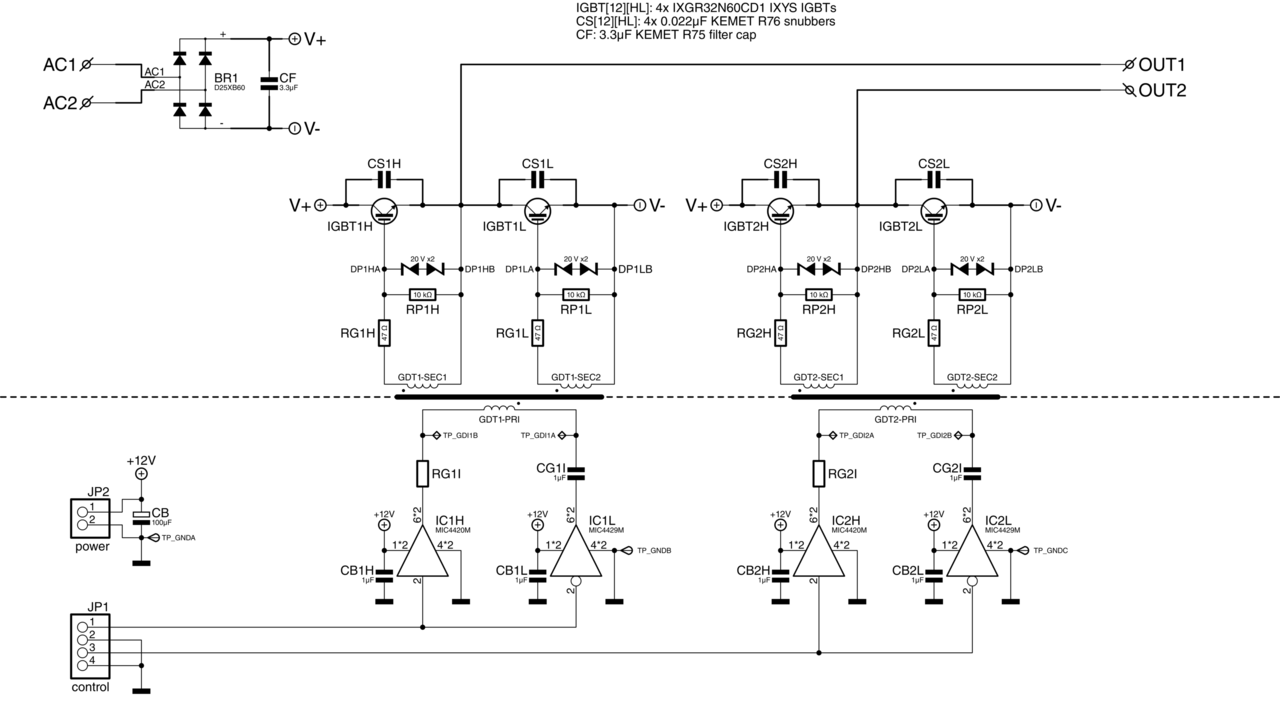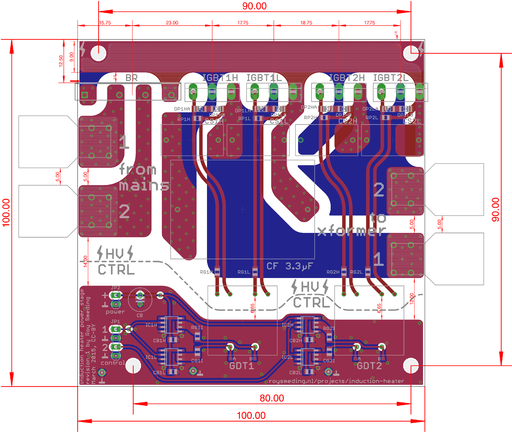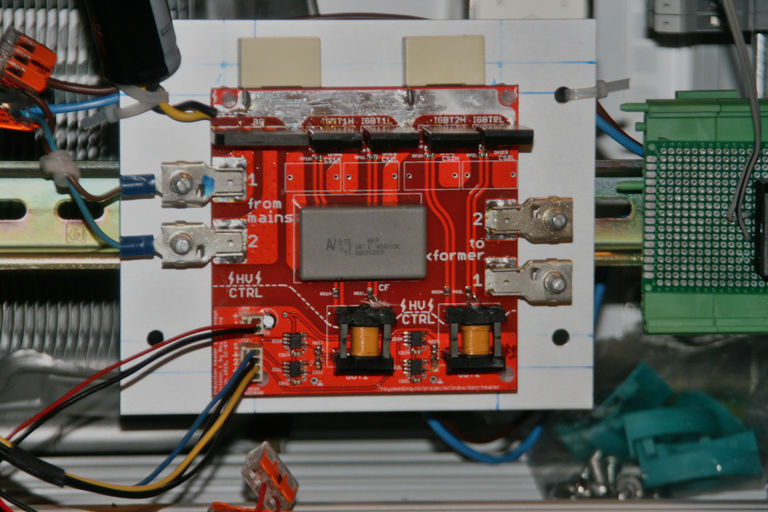InductionHeater: Difference between revisions
Expand the cost estimation |
mNo edit summary |
||
| (14 intermediate revisions by 6 users not shown) | |||
| Line 1: | Line 1: | ||
{{Project | {{Project | ||
|Name=InductionHeater | |Name=InductionHeater | ||
|Status= | |Picture=Hqdefault.jpg | ||
|Contact= smeding | |Status=In progress | ||
|Contact= smeding | |||
}} | }} | ||
We're working on an induction heater that can be used to heat anything conductive to high temperatures. The plan is to try to use it for forging steel and melting aluminum. | |||
== | Here are some examples of what a device like this is capable of: | ||
* [https://www.youtube.com/watch?v=0HdbKKvOiWU https://www.youtube.com/watch?v=0HdbKKvOiWU] | |||
* [https://www.youtube.com/watch?v=l7fArOvXhQY https://www.youtube.com/watch?v=l7fArOvXhQY] | |||
== System design == | |||
Induction heating works by applying a high-frequency magnetic field to the (conductive) workpiece being heated. Because of the [https://en.wikipedia.org/wiki/Skin_effect skin effect], conduction at these frequencies only occurs in a thin layer on the outside of the workpiece. This acts like the secondary winding of a transformer, allowing current to flow and heating the workpiece through resistive heating. | |||
The design consists of the following parts: | |||
* The power stage rectifies mains voltage, which is then chopped into a high-frequency 'modified square wave' with variable duty cycle and frequency. | |||
* The coupling transformer transforms the relatively high-voltage, low-current square wave into a lower-voltage, high-current one, to ease the requirements on the work coil. | |||
* The work coil is where the workpiece is placed to be heated. | |||
* The controller monitors relevant currents and voltages, and generates the waveforms that drive the power stage transistors. | |||
=== Specs === | |||
* Input power: Standard single-phase mains: 230V RMS, 16A max ⇒ 3.5kVA | |||
* Frequency: 10 kHz - 100 kHz | |||
* 500A absolute maximum current in work coil | |||
* 'Modified square wave' control: variable frequency and duty cycle | |||
=== Controller === | |||
The controller is based around a [http://www.st.com/content/st_com/en/products/microcontrollers/stm32-32-bit-arm-cortex-mcus/stm32f3-series/stm32f334.html STM32F334] ARM microcontroller. Its job is to generate the drive waveforms for the power stage, and display system status, based on measuring the relevant voltages and currents. | |||
=== Power stage === | |||
[[File:Induction_heater_power_stage_schematic.png|1280px|The power stage schematic.]] | |||
Shown above is the schematic for the power stage. Mains voltage enters on the top left, where it is rectified and filtered to get approximately 325 V DC. Then, four IGBTs (IGBT1H, -1L, -2H, and -2L) form an H-bridge that generates the 10-100 kHz 'modified square wave' for the transformer. | |||
The IGBTs are driven via gate-drive transformers (GDT1 and GDT2) so that the control circuitry can be isolated from the high-voltage side. These transformers in turn are driven by high-current MOSFET drivers (IC1H, -1L, -2H, and -2L), which receive their signals from the controller. | |||
[[File:Induction_heater_power_stage_board_layout.png|512px|The power stage board layout.]] | |||
[[File:Induction_heater_power_stage_board_assembled.jpg|768px|The assembled power stage board.]] | |||
| | |||
| | |||
| | |||
| | |||
== | === Coupling transformer === | ||
The coupling transformer converts the high-voltage low-current chopped mains waveform to low voltage and high current for the work coil. Using a separate coupling transformer relaxes the requirements on the workpiece coil, so it can be adapted more easily to the workpiece being heated. | |||
It'll be made from four stacked [https://www.aliexpress.com/item/Dark-Gray-Power-Transformers-Ferrite-Toroid-Cores-100mm-x-60mm-x-15mm/689128147.html 100 × 60 × 15 mm ferrite cores] (to provide enough core cross-sectional area for the magnetic field). The primary will consist of 60 turns of thick litz wire, and the secondary will be 2 turns of 15mm OD copper tubing, giving a winding ratio of 30:1. | |||
== Pledges == | |||
So far, the following has been pledged: | |||
* [[Gori]]: 50 euro | * [[Gori]]: 50 euro | ||
* [[Flok]]: 10 euro | * [[Flok]]: 10 euro | ||
* Walter: 50 евра | * Walter: 50 евра | ||
* FooBar: €20 | * FooBar: €20 cash betaald | ||
* [[bertrik]]: €10 | * [[bertrik]]: €10 | ||
* Semafoor: €20 ( | * Semafoor: €20 | ||
* [[Morphje]]: EUR 10 (and driving to the hardware store once) | |||
Total pledges: €170 | |||
Latest revision as of 11:49, 1 October 2016
| Project InductionHeater | |
|---|---|

| |
| Status | In progress |
| Contact | smeding |
| Last Update | 2016-10-01 |
We're working on an induction heater that can be used to heat anything conductive to high temperatures. The plan is to try to use it for forging steel and melting aluminum.
Here are some examples of what a device like this is capable of:
System design
Induction heating works by applying a high-frequency magnetic field to the (conductive) workpiece being heated. Because of the skin effect, conduction at these frequencies only occurs in a thin layer on the outside of the workpiece. This acts like the secondary winding of a transformer, allowing current to flow and heating the workpiece through resistive heating.
The design consists of the following parts:
- The power stage rectifies mains voltage, which is then chopped into a high-frequency 'modified square wave' with variable duty cycle and frequency.
- The coupling transformer transforms the relatively high-voltage, low-current square wave into a lower-voltage, high-current one, to ease the requirements on the work coil.
- The work coil is where the workpiece is placed to be heated.
- The controller monitors relevant currents and voltages, and generates the waveforms that drive the power stage transistors.
Specs
- Input power: Standard single-phase mains: 230V RMS, 16A max ⇒ 3.5kVA
- Frequency: 10 kHz - 100 kHz
- 500A absolute maximum current in work coil
- 'Modified square wave' control: variable frequency and duty cycle
Controller
The controller is based around a STM32F334 ARM microcontroller. Its job is to generate the drive waveforms for the power stage, and display system status, based on measuring the relevant voltages and currents.
Power stage
Shown above is the schematic for the power stage. Mains voltage enters on the top left, where it is rectified and filtered to get approximately 325 V DC. Then, four IGBTs (IGBT1H, -1L, -2H, and -2L) form an H-bridge that generates the 10-100 kHz 'modified square wave' for the transformer.
The IGBTs are driven via gate-drive transformers (GDT1 and GDT2) so that the control circuitry can be isolated from the high-voltage side. These transformers in turn are driven by high-current MOSFET drivers (IC1H, -1L, -2H, and -2L), which receive their signals from the controller.
Coupling transformer
The coupling transformer converts the high-voltage low-current chopped mains waveform to low voltage and high current for the work coil. Using a separate coupling transformer relaxes the requirements on the workpiece coil, so it can be adapted more easily to the workpiece being heated.
It'll be made from four stacked 100 × 60 × 15 mm ferrite cores (to provide enough core cross-sectional area for the magnetic field). The primary will consist of 60 turns of thick litz wire, and the secondary will be 2 turns of 15mm OD copper tubing, giving a winding ratio of 30:1.
Pledges
So far, the following has been pledged:
- Gori: 50 euro
- Flok: 10 euro
- Walter: 50 евра
- FooBar: €20 cash betaald
- bertrik: €10
- Semafoor: €20
- Morphje: EUR 10 (and driving to the hardware store once)
Total pledges: €170


